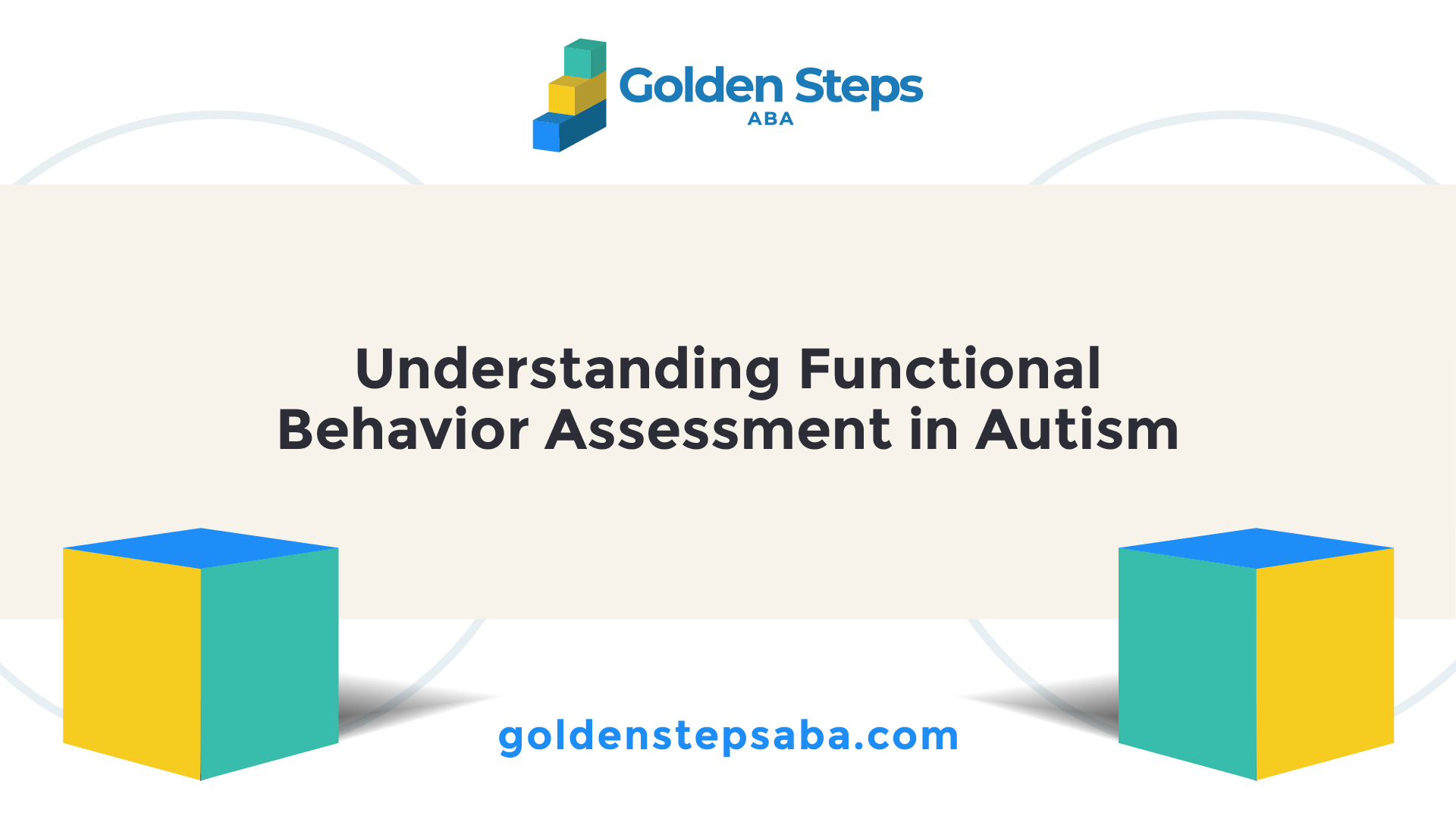Understanding Behavior Functions
In order to effectively manage behaviors in individuals with autism, it is essential to first understand the purpose or function of these behaviors. This is where the concept of Functional Behavior Assessment (FBA) comes into play.
Types of Behavior Functions
When it comes to Applied Behavior Analysis (ABA) in autism, behaviors can typically be categorized into five common types: escape/avoidance, attention-seeking, tangible reinforcement, sensory stimulation, and control/rigidity. These categories help to identify the underlying reasons or motivations for specific behaviors exhibited by individuals with autism.

Behavior FunctionDescriptionEscape/AvoidanceThe behavior is a means to escape or avoid a certain situation or activity.Attention-seekingThe behavior is a way to gain attention from others.Tangible ReinforcementThe behavior is driven by the desire to gain access to a specific item or activity.Sensory StimulationThe behavior provides some form of sensory input or stimulation.Control/RigidityThe behavior is associated with a need for control or routine.
Importance of Functional Behavior Assessment
Functional Behavior Assessments (FBAs) are essential tools used in ABA to determine the underlying function of a behavior. FBAs involve methods such as direct observation, interviews with parents and practitioners, and functional analysis to gather data on antecedents (what happens before the behavior) and consequences (what happens after the behavior) associated with the behavior [1].
Understanding the functions of behavior is a valuable tool that empowers parents, teachers, and practitioners to develop effective action plans tailored to individual needs. It ultimately promotes positive outcomes and creates a supportive and inclusive environment for individuals with autism.
Identifying the function of behavior in autistic children helps prevent problem behavior, teaches better ways to meet their needs, ensures consistency across environments, and increases appropriate behaviors while decreasing problem behaviors. This underlines the importance of a Functional Behavior Assessment in autism and paves the way for the development of an individualized behavior intervention plan.
Conducting Functional Behavior Assessment
To manage challenging behaviors in individuals with autism, a Functional Behavior Assessment (FBA) can be an invaluable tool. An FBA allows us to understand the purpose or function of certain behaviors, providing the foundation for the creation of a tailored behavior intervention plan.
Methods of FBA
Functional Behavior Assessments (FBAs) involve a range of strategies to determine the underlying function or purpose of a behavior. These strategies can include direct observation, interviews with parents, teachers, and practitioners, and functional analysis.
Gathering data through interviews, surveys, observations, and record reviews helps come up with a hypothesis of function. Functional Analysis (FA), which involves experimentally controlling variables to test the hypothesis, is typically conducted in clinical settings and is part of an FBA [4].
To determine the function of a behavior in students with autism, data can be collected using methods such as the Functional Analysis Screening Tool (FAST) and completing an ABC (antecedent, behavior, consequence) chart [5].
Data Collection and Analysis
During an FBA, a school team collects information and uses it to create a plan to improve behavior. The steps include defining the challenging behavior, gathering and analyzing information, determining the reason for the behavior, and making a plan based on the collected information [6].
The data collection phase may involve utilizing tools and charts, such as the ABC chart mentioned earlier. This chart helps in recording the Antecedent (what happened before the behavior), the Behavior itself, and the Consequence (what happened after the behavior).
The collected data is then analyzed to identify patterns and trends. The aim of this analysis is to understand the circumstances and triggers leading to the challenging behavior. This analysis can provide valuable insights to inform the creation of an effective behavior intervention plan.
It's important to remember that conducting an FBA is not a one-time process. It involves consistent data collection and analysis, and adjustments to the behavior intervention plan as needed. Understanding the functional behavior assessment in autism is a crucial step towards managing and improving challenging behaviors in individuals with autism.
Developing Behavior Action Plans
After conducting a functional behavior assessment for autism, the next step is to develop a behavior action plan. This involves creating targeted interventions and adopting a collaborative approach.
Targeted Interventions
Once the function of a behavior is identified through FBA, targeted behavior action plans can be developed. These plans aim to address the root cause of the behavior and teach alternative skills. Strategies for addressing specific behavior functions include teaching coping mechanisms, providing positive attention, teaching communication skills, and implementing sensory routines.
When working to decrease problem behaviors in students with autism, it is essential to teach a replacement behavior that serves the same function as the problem behavior. By recognizing and understanding the functions of behavior, professionals can develop targeted Behavior Intervention Plans (BIPs) that address the specific function of the behavior, leading to positive outcomes and reduced challenging behaviors.
For more information on implementing a behavior intervention plan for autism, check out our article on behavior intervention plan autism.
Collaborative Approach
A collaborative approach is essential in developing and implementing effective behavior action plans. If a student with autism displays problem behaviors that disrupt learning, a Functional Behavior Assessment (FBA) should be conducted by a Board Certified Behavior Analyst (BCBA).
Once the FBA is completed and the function of the behavior is identified, a Behavior Intervention Plan should be developed. This plan should include input from all team members involved in the student's care, including parents, teachers, therapists, and other support staff.
The team should be trained on the plan to ensure consistent implementation across all settings. Ongoing support and frequent communication among team members are necessary for the successful implementation and monitoring of the plan.
Understanding the function of behavior in autism can help decrease problem behaviors and increase appropriate or desired behaviors in children. This is achieved through a structured approach of observation, analysis, and intervention. By working together, the team can ensure that the behavior action plan is effectively implemented and that the child receives the necessary support to succeed.
Behavior Functions in Autism
In the context of Autism Spectrum Disorder (ASD), understanding behavior functions plays a crucial role in managing and improving behavior patterns. The behavioral functions can be quite diverse, but certain common patterns are observed in individuals with autism.
Common Functions in Autism
Behavior functions in Applied Behavior Analysis (ABA) can be broadly categorized into five common types: escape/avoidance, attention-seeking, tangible reinforcement, sensory stimulation, and control/rigidity. These functions help identify the underlying reasons for specific behaviors exhibited by individuals with autism.
Another perspective categorizes the functions of behavior in autism into four groups: sensory stimulation, escape, access to attention, and access to tangibles. All these functions are identified through data collection and analysis by a BCBA [2].
Behavior FunctionDescriptionEscape/AvoidanceThe behavior aims to escape or avoid a certain situation or task.Attention-seekingThe behavior is intended to gain attention from others.Tangible ReinforcementThe behavior is used to gain access to specific items or activities.Sensory StimulationThe behavior provides a certain sensory input to the individual.Control/RigidityThe behavior is a way to maintain control or resist change.
Impact on Behavior Management
Recognizing the function of behavior in children with autism is a key step in managing and altering problematic behaviors. It helps prevent problem behavior, teach better ways to meet their needs, ensure consistency across environments, and increase appropriate behaviors while decreasing problem behaviors.
Understanding the function of behavior in autism helps decrease problem behaviors and increase appropriate or desired behaviors in children through a structured approach of observation, analysis, and intervention.
Problem behaviors in students with autism are often caused by socially mediated positive reinforcement (e.g., attention or access to tangibles) and socially mediated negative reinforcement (e.g., escape from demand), with a combination of both being common. Assessments like VB-MAPP can help identify these issues and guide programming to address them.
By understanding the functional behavior assessment autism, caregivers and professionals can devise effective behavior intervention plans tailored to the unique needs of individuals with autism. This personalized approach is key to making meaningful and long-lasting improvements in behavior management.
Practical Applications
Understanding the functional behavior assessment autism is not only beneficial for understanding the underlying reasons for a behavior but also provides practical applications for managing and modifying behaviors.
Behavior Analysts' Role
Behavior analysts play a crucial role in the process of functional behavior assessment. They utilize the functions of behavior to identify why a behavior is occurring, guiding the treatment planning for problem behaviors. This process often involves observing the child in various environments, describing events before and after problem behaviors occur, and identifying the function of the behavior. This comprehensive understanding of behaviors aids in teaching replacement behaviors that meet the same needs, reinforcing these replacement behaviors to decrease problem behaviors.
If a student with autism displays problem behaviors that disrupt learning, a functional behavior assessment should be conducted by a Board Certified Behavior Analyst (BCBA). This assessment includes analyzing both verbal and non-verbal operants, as well as academic areas, to understand the root causes of the behaviors and develop appropriate interventions.
Implementing Behavior Intervention Plans
Once a functional behavior assessment has been conducted and the functions of behavior have been identified, the next step is to develop a targeted behavior intervention plan (BIP). This plan should address the specific function of the behavior, leading to positive outcomes and reduced challenging behaviors.
Implementing a BIP involves training staff on the plan and providing ongoing support. This can include teachers, paraprofessionals, and other support staff who interact with the child. The focus of the BIP is not only to manage and decrease problem behaviors but also to teach and reinforce replacement behaviors that fulfill the same function for the child.
For more detailed information on creating and implementing a BIP, visit our guide on behavior intervention plan autism.
In conclusion, the practical applications of functional behavior assessment in autism involve understanding the function of behaviors, conducting a comprehensive assessment, and implementing targeted intervention plans. This process can lead to positive behavior changes, improved learning outcomes, and a more supportive environment for the child with autism.
Utilizing FBAs in Education
Functional Behavior Assessments (FBAs) play a critical role in educational settings, especially for students with autism who may exhibit challenging behaviors. These assessments provide valuable insights into why certain behaviors occur, thereby guiding the development of effective intervention strategies.
Integration in IEPs
FBAs are increasingly being incorporated into Individualized Education Programs (IEPs) for students with autism who exhibit undesirable behaviors in school settings.
An FBA is typically conducted as part of a school evaluation for special education, when new behavior concerns arise with students who have an IEP or a 504 plan, and in certain school discipline situations where federal law requires an FBA in specific circumstances [6].
Most funding sources also require an FBA before treatment for autism can be initiated. Sometimes, an FBA may be required at regular intervals, especially if new problem behaviors occur [4].
These assessments are then integrated into the student's IEP to guide the development of a personalized behavior intervention plan.
Supporting Positive Behavior Changes
FBAs involve various methods such as direct observation, interviews with parents, teachers, and practitioners, and functional analysis to assess the impact of antecedents and consequences on behavior. This provides valuable information for designing individualized behavior intervention plans.
The use of FBAs in education supports positive behavior changes by helping educators and support staff understand why a student is using unwanted behaviors and how they can be replaced with more appropriate ones.
Collaboration among parents, teachers, and practitioners is essential in understanding and addressing behavior functions, ensuring a supportive environment for the student, and promoting positive behavior change [3].
By utilizing FBAs in education settings, educators and support staff can create a more inclusive and supportive environment for students with autism, fostering their academic success and social development.

